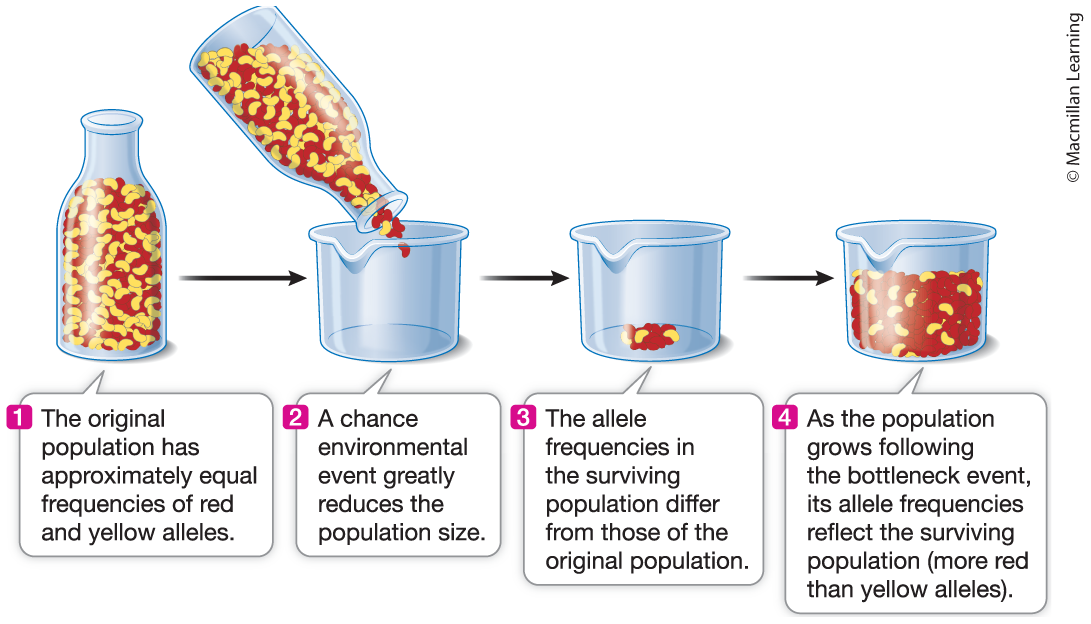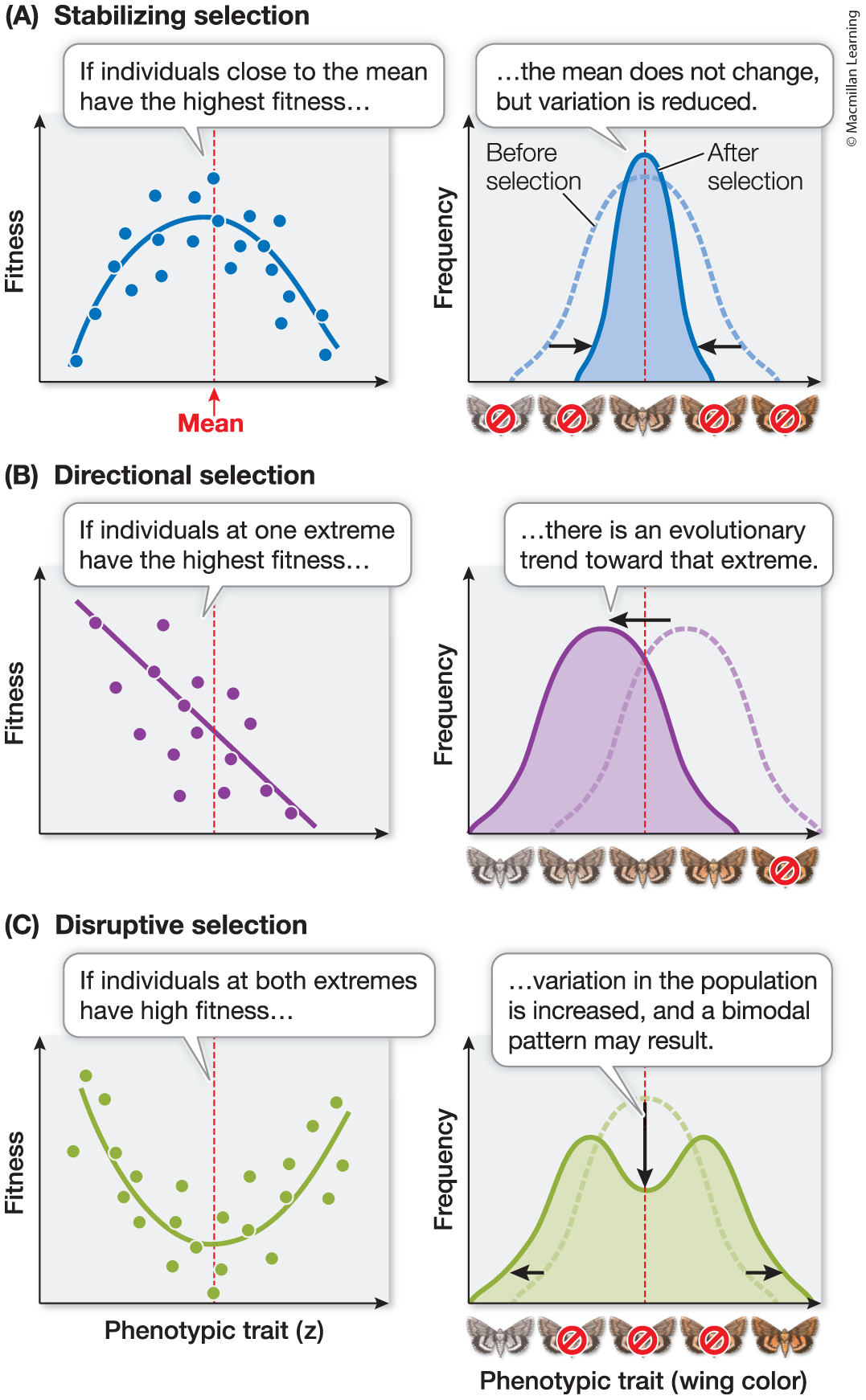
Principles of Life, Ch. 13 Reading
13.1 Evolution is Both Factual and the Basis of Broader Theory
Evolution: Any gradual change. Most often refers to organic or Darwinian evolution, which is the genetic and resulting phenotypic change in populations of organisms from generation to generation.
Evolutionary Theory: The understanding and application of the mechanisms of evolutionary change to biological problems.
Darwin’s Theory
Species are not immutable; they change over time.
Descent with Modification: Darwin’s premise that all species share a common ancestor and have diverged from one another gradually over time.
Natural Selection: The differential contribution of offspring to the next generation by various genetic types belonging to the same population. The mechanism of evolution proposed by Charles Darwin.
Darwin realized that many more individuals of most species are born than survive to reproduce.
Artificial Selection: Selective breeding of organisms, commonly practiced by animal and plant breeders, to increase the frequency of a favored trait from one generation to the next.
Alfred Russel Wallace also proposed natural selection at the same time
13.2 Mutation, Selection, Gene Flow, Genetic Drift, and Nonrandom Mating Result in Evolution
Population: In ecology, a group of individuals of the same species that live, interact, and reproduce together in a particular geographic area.
Individuals do NOT evolve.
The origin of genetic variation is mutation.
Alleles: A specific form of a gene at a given locus on a chromosome, among multiple possible forms.
Gene Pool: All of the different alleles of all of the genes existing in all individuals of a population.
Allele Frequency: The proportion of each allele in a gene pool.
Genotype Frequency: The proportion of each genotype among individuals in a population.
Adaptation: In evolutionary biology, a particular structure, physiological process, or behavior that makes an organism better able to survive and reproduce. Also, the evolutionary process that leads to the development or persistence of such a trait.
Biologists regard an organism as being adapted to a particular environment when they can demonstrate that a slightly different organism reproduces and survives less well in that environment
Gene Flow: Exchange of genes between populations through migration of individuals or movements of gametes.
Genetic Drift: Changes in gene frequencies from generation to generation as a result of random (chance) processes.
Population Bottleneck: A period during which only a few individuals of a normally large population survive.

Founder effect: Random changes in allele frequencies resulting from establishment of a population by a very small number of individuals.
Sexual Selection: Selection by one sex of characteristics in individuals of the opposite sex. Also, the favoring of characteristics in one sex as a result of competition among individuals of that sex for mates.
13.3 Evolution Can Be Measured by Changes in Allele Frequencies
Genetic Structure: The frequencies of the different alleles at each locus and the frequencies of the different genotypes in a population.
Hardy-Weinberg Equilibrium: The expected frequencies of alleles and genotypes in a population under random mating, in the absence of natural selection, mutation, migration, and genetic drift.
Hardy-Weinberg only applies to sexually reproducing organisms.
Conditions for Hardy-Weinberg equlibrium:
There is no mutation
There is no selection among genotypes
There is no gene flow
Population size is infinite
Mating is random
Populations in nature never meet the conditions for Hardy–Weinberg equilibrium, which is why we can say all biological populations evolve.
13.4 Selection Can be Stabilizing, Directional, or Disruptive
Fitness: An individual’s contribution of genes to the next generation, as a consequence of its success in surviving and reproducing.
Fitness of a phenotype is determined by the relative rates of survival and reproduction of individuals with that phenotype.
Stabilizing Selection: Selection against the extreme phenotypes in a population, so that the intermediate types are favored.
Directional Selection: Selection in which phenotypes at one extreme of the population distribution are favored.
Disruptive Selection: Selection in which phenotypes at both extremes of the population distribution are favored.

Purifying Selection: The elimination by natural selection of detrimental characters from a population.
Positive Selection: Natural selection that acts to establish a trait that enhances survival in a population.
When disruptive selection operates, individuals at opposite extremes of a character distribution contribute more offspring to the next generation than do individuals close to the mean, which increases variation in the population
13.5 Selection Can Maintain Polymorphisms in Populations
Frequency-Dependent Selection: Selection that changes in intensity with the proportion of individuals in a population having the trait.
Genetic variation within species is maintained in geographically distinct populations
Clinal Variation: Gradual change in the phenotype of a species over a geographic gradient.
Principles of Life, Ch. 13 Reading
13.1 Evolution is Both Factual and the Basis of Broader Theory
Evolution: Any gradual change. Most often refers to organic or Darwinian evolution, which is the genetic and resulting phenotypic change in populations of organisms from generation to generation.
Evolutionary Theory: The understanding and application of the mechanisms of evolutionary change to biological problems.
Darwin’s Theory
Species are not immutable; they change over time.
Descent with Modification: Darwin’s premise that all species share a common ancestor and have diverged from one another gradually over time.
Natural Selection: The differential contribution of offspring to the next generation by various genetic types belonging to the same population. The mechanism of evolution proposed by Charles Darwin.
Darwin realized that many more individuals of most species are born than survive to reproduce.
Artificial Selection: Selective breeding of organisms, commonly practiced by animal and plant breeders, to increase the frequency of a favored trait from one generation to the next.
Alfred Russel Wallace also proposed natural selection at the same time
13.2 Mutation, Selection, Gene Flow, Genetic Drift, and Nonrandom Mating Result in Evolution
Population: In ecology, a group of individuals of the same species that live, interact, and reproduce together in a particular geographic area.
Individuals do NOT evolve.
The origin of genetic variation is mutation.
Alleles: A specific form of a gene at a given locus on a chromosome, among multiple possible forms.
Gene Pool: All of the different alleles of all of the genes existing in all individuals of a population.
Allele Frequency: The proportion of each allele in a gene pool.
Genotype Frequency: The proportion of each genotype among individuals in a population.
Adaptation: In evolutionary biology, a particular structure, physiological process, or behavior that makes an organism better able to survive and reproduce. Also, the evolutionary process that leads to the development or persistence of such a trait.
Biologists regard an organism as being adapted to a particular environment when they can demonstrate that a slightly different organism reproduces and survives less well in that environment
Gene Flow: Exchange of genes between populations through migration of individuals or movements of gametes.
Genetic Drift: Changes in gene frequencies from generation to generation as a result of random (chance) processes.
Population Bottleneck: A period during which only a few individuals of a normally large population survive.

Founder effect: Random changes in allele frequencies resulting from establishment of a population by a very small number of individuals.
Sexual Selection: Selection by one sex of characteristics in individuals of the opposite sex. Also, the favoring of characteristics in one sex as a result of competition among individuals of that sex for mates.
13.3 Evolution Can Be Measured by Changes in Allele Frequencies
Genetic Structure: The frequencies of the different alleles at each locus and the frequencies of the different genotypes in a population.
Hardy-Weinberg Equilibrium: The expected frequencies of alleles and genotypes in a population under random mating, in the absence of natural selection, mutation, migration, and genetic drift.
Hardy-Weinberg only applies to sexually reproducing organisms.
Conditions for Hardy-Weinberg equlibrium:
There is no mutation
There is no selection among genotypes
There is no gene flow
Population size is infinite
Mating is random
Populations in nature never meet the conditions for Hardy–Weinberg equilibrium, which is why we can say all biological populations evolve.
13.4 Selection Can be Stabilizing, Directional, or Disruptive
Fitness: An individual’s contribution of genes to the next generation, as a consequence of its success in surviving and reproducing.
Fitness of a phenotype is determined by the relative rates of survival and reproduction of individuals with that phenotype.
Stabilizing Selection: Selection against the extreme phenotypes in a population, so that the intermediate types are favored.
Directional Selection: Selection in which phenotypes at one extreme of the population distribution are favored.
Disruptive Selection: Selection in which phenotypes at both extremes of the population distribution are favored.

Purifying Selection: The elimination by natural selection of detrimental characters from a population.
Positive Selection: Natural selection that acts to establish a trait that enhances survival in a population.
When disruptive selection operates, individuals at opposite extremes of a character distribution contribute more offspring to the next generation than do individuals close to the mean, which increases variation in the population
13.5 Selection Can Maintain Polymorphisms in Populations
Frequency-Dependent Selection: Selection that changes in intensity with the proportion of individuals in a population having the trait.
Genetic variation within species is maintained in geographically distinct populations
Clinal Variation: Gradual change in the phenotype of a species over a geographic gradient.
 Knowt
Knowt
